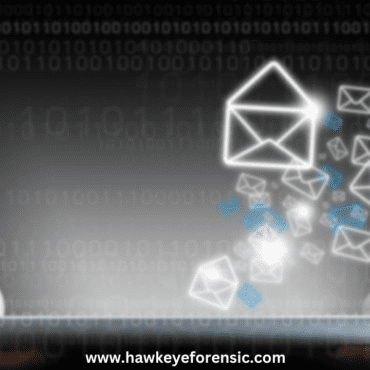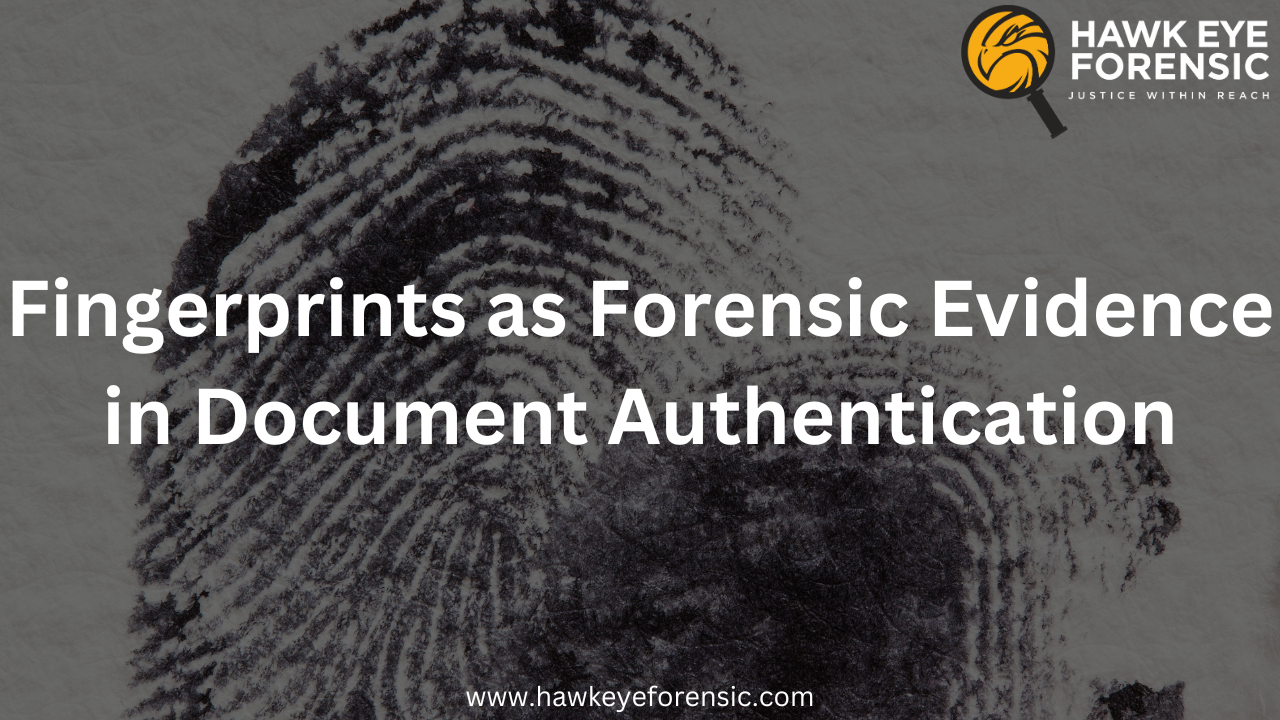Introduction
Document forgery is a widespread problem affecting finance, government, healthcare, law enforcement, and commerce industries. Examples of fraudulent activities that compromise the integrity and authenticity of documents include altered documents, forged fingerprints, counterfeit identity, and forged signatures. Fingerprints provide a unique and reliable way to identify people. Unlike seals or signatures, which can be easily replicated or altered, fingerprints are linked to an individual’s identification and cannot be easily forged. They act as reliable markers of validity and provide crucial evidence for verifying the authenticity of documents.
Understanding Document Forgery and Fingerprints
Document forgery refers to a variety of illegal activities that aim to deceive individuals, organizations, or authorities through falsification, alteration, or misrepresentation of official documents. For example, we look at common types of document forgery such as forged signatures on contracts, altered financial records, forged fingerprints, counterfeit identification documents, and falsified educational credentials. These fraudulent acts have major implications, undermining confidence, financial stability, and legal validity.
Fingerprints are the intricate patterns carved on our skin that reveal unique details about our identity. These develop during fetal development and remain unique throughout our lives. Fingerprints consist of ridges and valleys and are divided into loops, whorls, and arches.
- Loops: Loops are the most common type of fingerprint pattern, accounting for approximately 60-65% of all fingerprints. In a loop pattern, the ridges enter from one side of the finger, curve around, and exit from the same side, forming a loop-like shape. Loops can further be sub-classified into radial loops (opening toward the thumb) and ulnar loops (opening toward the little finger).
- Whorls: Whorls are characterized by concentric or spiral patterns that resemble a bullseye. In a whorl pattern, the ridges form circular or elliptical shapes, with two or more deltas (triangular-shaped patterns) present. Whorls account for approximately 30-35% of all fingerprints.
- Arches: Arches are characterized by ridges that flow from one side of the finger to the other in a continuous, wave-like pattern. Arches lack the distinct looping or whirling patterns seen in loops and whorls. They are relatively less common, comprising around 5% of all fingerprints.
Fig. 1: Types of Fingerprints
Fig. 2: Fingerprints depicting Ridges and Valleys
The Significance of fingerprints in document forgery detection
- Uniqueness: Fingerprints are unique to each individual; even identical twins have different fingerprints. This uniqueness makes fingerprints an excellent biometric identifier for verifying the identity of individuals.
- Difficult to Forge: Fingerprints are difficult to forge or replicate accurately. Unlike signatures or other identification methods, it is extremely challenging to create a fake fingerprint that matches the intricate details of a genuine print.
- Forensic Evidence: Fingerprints are considered one of the most reliable forms of forensic evidence. They can be lifted from surfaces and used to identify individuals involved in criminal activities, including document forgery.
- Authentication: Fingerprints can be used to authenticate the identity of individuals when they are required to provide biometric data for document verification processes. This adds an extra layer of security to prevent document fraud.
- Integration with Technology: With advancements in technology, fingerprint recognition systems have become more accessible and accurate. They are commonly integrated into various devices and systems, including smartphones, tablets, and security access controls. This widespread adoption of fingerprint recognition technology enhances its utility in document fraud detection.
- Verification in Government Documents: Many government-issued documents, such as passports, visas, and identity cards, now incorporate biometric data, including fingerprints, for verification purposes. This helps authorities detect any attempts of document fraud by cross-referencing the fingerprints provided with those stored in official databases.
- Deterrent to Fraudsters: The presence of fingerprint verification systems acts as a deterrent to potential fraudsters. Knowing that their fingerprints can be used to verify their identity, individuals are less likely to attempt document fraud.
Process of forensic fingerprint examination
Forensic fingerprint examination is a meticulous process that involves several steps to analyze and compare fingerprints for identification purposes. Below is a summary of the standard procedure:
- Collection of Prints: The first step in forensic fingerprint examination is the collection of fingerprint evidence. This may involve collecting the questioned document bearing the fingerprints or impressions and obtaining the known prints that are to be examined or compared for their similarities/differences.
- Preservation and Documentation: The questioned fingerprints must be carefully preserved to prevent contamination or damage. They are usually documented through photography or other methods to create a record of the original evidence.
- Analysis of Prints: Forensic examiners analyze the questioned fingerprints to assess their quality and suitability for comparison. This involves examining the clarity of ridge detail, the presence of smudging or distortion, and other factors that may affect the accuracy of comparison.
- Comparison: In this step, forensic examiners compare the questioned fingerprints with known prints. The comparison involves looking for similarities in ridge patterns, minutiae points, orientation, shape, size, and other identifying features.
- Evaluation of Similarities/Differences: During comparison, examiners identify and document similarities/differences between the questioned prints and known prints. This may involve marking corresponding minutiae points and other features to demonstrate the degree of similarity.
- Verification and Confirmation: After identifying potential matches, forensic examiners conduct a thorough verification process to ensure the accuracy of their findings. This may involve peer review, additional analysis, or the use of advanced forensic techniques.
- Report Writing: Forensic examiners document their findings in a detailed report, including descriptions of the collected prints, the comparison process, and the results of the analysis. The report serves as an official record of the examination and may be used as evidence in legal proceedings.
- Expert Testimony: In some cases, forensic examiners may be called upon to provide expert testimony in court to explain their findings and the process of fingerprint examination. They may be required to present their conclusions and answer questions from attorneys, judges, and jurors.
Challenges & Limitations
- Partial Prints – Fingerprints are often incomplete, distorted, and smudged, making analysis difficult.
- Quality Issues – Variations in pressure, oils on fingers, and document surface impact print clarity. Poor-quality prints hinder accurate analysis, posing a challenge to forensic examiners.
- Need Clear Benchmarks – Defining acceptable source levels for “matching” remains subjective. Variations in the methods or standards employed by different forensic examiners or labs may lead to discrepancies in the analysis and interpretation.
- Human Error – Examiner bias, skill differences, and methodology variance impact results.
- Background Noise: The presence of extraneous marks, smudges, or patterns on the document’s surface can create visual “noise” that makes it challenging to distinguish and interpret fingerprints accurately.
- Legal challenges: during court proceedings, there’s a possibility that legal challenges may arise. The defense may challenge fingerprint evidence, citing issues like the chain of custody or examiner qualifications. This underscores the importance of strict procedural adherence in evidence handling.
Ultimately, fingerprint identification relies on the expertise of certified examiners and clear benchmarks for making conclusive matches. The process has an inherent degree of remaining subjectivity. Emerging digital analysis techniques aim to make matching more quantitative and consistent. Quality issues are often encountered, especially with documents bearing fingerprints.
Legal implications and admissibility of fingerprint evidence
Courts typically follow established legal standards for admitting fingerprint evidence, which may vary depending on jurisdiction. These standards often require that the evidence meets certain criteria, such as relevance, reliability, and authenticity.
- Relevance: Courts assess whether the fingerprint evidence is relevant to the case at hand and whether it tends to prove or disprove a material fact.
- Reliability: Courts evaluate the reliability of fingerprint evidence by considering factors such as the quality of the prints, the expertise of the forensic examiner, and the accuracy of the analysis.
- Authentication: Courts may require evidence to establish the chain of custody and authenticity of the fingerprint samples, ensuring that they have not been tampered with or contaminated.
- Prejudicial Impact: Courts weigh the probative value of fingerprint evidence against any potential prejudice it may cause to the defendant, ensuring a fair trial.
Applications beyond document forgery detection
Criminal Investigations: Fingerprint analysis is a cornerstone of forensic science and is widely used in criminal investigations to link suspects to crime scenes, identify unknown individuals, and establish connections between different cases. Example: In the case of the “Golden State Killer,” Joseph James DeAngelo, fingerprints found at crime scenes spanning several decades were crucial in linking him to multiple murders and rapes, leading to his arrest and conviction in 2018.
Historical Research: Fingerprint analysis has applications in historical research, where it can help identify individuals in archival photographs, authenticate historical documents, and provide insights into past events and interactions. Example: Fingerprint analysis has been used to identify individuals in historical photographs, such as the identification of soldiers in Civil War-era photos or the verification of individuals in archival records.
Art Authentication: Fingerprint analysis is utilized in the authentication of artwork and artifacts, helping to establish provenance, detect forgeries, and verify the authenticity of valuable pieces. Example: Fingerprint analysis has been employed in the authentication of artwork, such as verifying the authenticity of paintings attributed to famous artists like Leonardo da Vinci or Vincent van Gogh. In one notable case, fingerprint analysis helped authenticate a painting thought to be a lost work by Johannes Vermeer.
Conclusion
Since fingerprints provide unquestionable proof of identity and authenticity, they are essential in combating document forgery. They are crucial for preserving integrity across various fields because of their reliability and permanence. We must prioritize fingerprint analysis in document verification processes to fortify defenses against fraud and uphold trust and transparency in society. In essence, fingerprints serve as silent guardians of truth, urging us to embrace their importance in our pursuit of justice and integrity.
References
- TY – JOUR AU – Sharma, Bhoopesh AU – Walia, Megha AU – Sharma, Satish AU – Kumar, Nishith PY – 2022/12/26 SP – 57 EP – 61 T1 – Fingerprint Science: A Review on Historical And Contemporary Forensic Perspectives VL – ER –
- TY – BOOK AU – Gao, Qinghai AU – Pinto, Daniel PY – 2016/04/01 SP – 1 EP – 7 T1 – Some challenges in forensic fingerprint classification and interpretation VL – DO – 10.1109/LISAT.2016.7494096 ER –







Post comments (0)